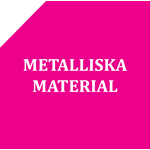Projektinitiativ #87: clean steel production through an inproved separation of inclusions to the slag (1 kommentar)
The steel makers have always focused on developing cleaner steels to improve the material properties of steel in order to make it more useful for the current applications as well as to find new applications. A key aspect with respect to development of cleaner steels with fewer inclusions is to understand how the separation of inclusions at a steel/slag interface can be optimized.
One important aspect to consider with respect to an improved inclusion separation is the slag/steel interface. It is commonly accepted that most chemical reactions reach thermodynamic equilibrium locally at steelmaking temperatures. To the knowledge of the present authors, the models describing the slag-metal reactions have all made this assumption [1-4]. However, ladle treatment is to great extent based on slag-metal reaction. While the assumption of local equilibrium may be good enough for impurity removal, it cannot meet the requirement for the study of inclusion generation and separation (see the discussion below). It should also be noted that one study [5] suggested that it is beneficial to generate a slag-metal emulsification to promote slag-metal reactions such as desulphurization. However, an increased stirring intensity could introduce more non-metallic inclusions from the slag to the steel, even if for example the collision growth in the melt would be promoted by an increa sed stirring.
In order to consider inclusion separation, it is also of course necessary to consider the source of inclusions. Here, most previous studies on inclusion generation have focused on nucleation of deoxidation products and slag entrainment. For homogeneous nucleation, the size and generating rate are very often evaluated by the classical nucleation theory.[6-9] While these models are theoretically valuable for improving our understanding for the formation of inclusions nucleated homogeneously, the use of these models in process is still difficult. This difficulty is not due to the models themselves, but because of the serious lack of the process information. Recently, more and more attention has also been drawn to the role of ladle glaze as a source of non-metallic inclusions in molten steel [10-17]. The formation of inclusion by slag entrainment has been discussed by many researchers. Krishnapisharody and Irons [18] came to the conclusion that the momentum of interfacial shear was not s ignificant for emulsification of oil but it is rather triggered by Kelvin-Helmholtz instability when two stratified fluids are in relative motion.
It is also important to discuss the models that have been developed to predict separation of inclusions at a steel/slag interface. Here, most models assumed that all inclusions reaching the interface between the steel and the slag would be separated from the steel. [19-21] Realizing the importance of interfacial energy and liquid metal film in the removal of inclusions to the slag, researchers later developed detailed models taking these factors into consideration. [22-25]. These models have a sound physical description of the phenomena when inclusions crossing the slag-metal interface. Nakajima and his co-works applied the model to both solid inclusions [22, 23] and liquid inclusions [25]. On the basis of the model calculation, Strandh et al [25] reported that there could be three types of inclusion behaviours at the interface, namely (1) remaining, (2) oscillation and (3) passing. Chevrier and Cramb[26] report that even the inclusions having the size larger than 1 mm would stay at the slag-metal interface for about 11sec before entering the slag. It is well known that the surface velocity of the liquid metal could be very high, 0.1-0.7 m/s. The strong drag force due to the high liquid velocity can likely bring the inclusions back to the steel bulk. Many inclusions are found to follow the metal flow coming out from the open-eye region without being separated to the slag.[27] .
The current project will use the knowledge from all these projects when studying the separation of inclusions from the steel to the slag. However, a new novel approach will be taken. It is well known in industry that the steel and slag have a reached an equilibrium after a successful vacuum treatment. Thus, during the remaining part of the ladle treatment the top slag is known to be chemically inactive (“dead”). This is good from many point-of-views, such as that the slag will not cause reoxidation or formation of new inclusions due to slag dispersion into steel, if the stirring is not to high. Since the slag is so chemically inactive, it gives us an opportunity to try to modify the inclusions by an addition to the steel that will transform the inclusions that more easily can be separate from the steel to the slag, under gentle stirring conditions.
Namn pär jönsson
Organisation KTH Materialvetenskap
Kommentar #1
In order either to minimize or control the inclusions for "the steels of the future" it is important to increase the knowledge of how to remove the inclusions the and how to prevent them to reenter the steel from the slag.
Namn Ewa Sjöqvist Persson
Organisation Uddeholms AB

